Propaganda Sources
1/14
There's no tags or description
Looks like no tags are added yet.
Name | Mastery | Learn | Test | Matching | Spaced |
|---|
No study sessions yet.
15 Terms
Propaganda
An attempt to influence peoples’ opinions or behaviour through the use of specific images and words
Propaganda Poster Elements
Stereotypes
Symbolism
Text
Connection with the audience
Appeal to Emotion
Call to Action
Stereotypes
An over-simplification of what a particular racial group looks like. Stereotypes are used so audiences can readily identify which people group is the target of the poster.
eg. Chinese people in the 19th century were drawn with a long pony-tail in their hair.
Common Stereotypes - Germans
spiked helmet, gorilla-like body
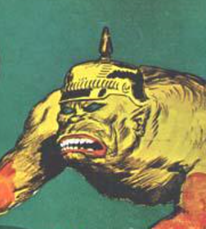
Common Stereotypes - Chinese
Long pony-tail, narrow eyes, thin moustache, traditional Chinese clothes and hat, two large front teeth
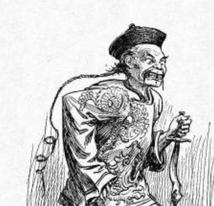
Common Stereotypes - Japanese
Circular glasses, narrow eyes, toothy grin
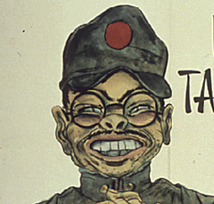
Common Stereotypes - Australian
Slouch hat, clean-shaven, khaki clothes
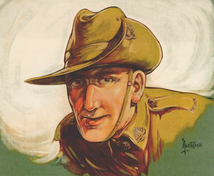
Symbolism
Are used to represent important concepts or ideas.
eg. ‘skull and crossbones’ could represent ‘death’ or ‘danger’
Common symbols used in propaganda
Symbol | Meaning(s) |
Bear | Russia |
Bulldog | Great Britain |
Eagle / Stars & Stripes / Uncle Sam | America |
Hammer & Sickle / Red Star | Communism |
Star of David | Jewish / Israel |
Swastika | Nazis |
Woman with scales | Justice |
Octopus | Greed |
Spider/web | control, entrapment |
Puppet | being Controlled |
Text
This information provides the audience with just enough data for them to draw the conclusion the creator wanted them to make. Ask whether the information provided is completely accurate or what other information has been left out. Finally, try to work out why the propaganda wanted the audience to know about the specific information they have presented.
eg. How does this information help persuade the audience?
Connection with the Audience
Propagana uses the second person pronoun "you" in the text,
ask a rhetorical question that the audience is meant to think about,
or it will have people in the poster looking directly at the viewer.
Propaganda does this in order to make the audience feel like they need to respond in some way.
Appeal to Emotion
Propaganda trys to play on a person's emotions in order to prompt them to respond. The most frequent emotional responses posters try to generate are:
guilt (making the audience feel like they have failed),
patriotism (appealing to the love of their country),
fear (that if they don't act, something bad will happen),
shame (that they are weak, cowardly or selfish).
Call to Action
Almost every propaganda poster has a statement about what their audience should do after seeing the poster. eg: 'Enlist Today!' or 'Buy War Bonds'.
The call to action is often the best way to determine the poster's purpose and intended audience.
Interpreting Posters
Who or what is represented by the stereotypes and symbols?
What information is provided by the text in the poster?
How does the poster try and connect directly with the audience? (Using "you", asking a question, or by 'looking at the audience'?)
What does the 'call to action' say?
What emotion is the viewer supposed to feel? (e.g. Shame, guilt, patriotism, etc.)
What did the propaganda want their audience to believe and do?
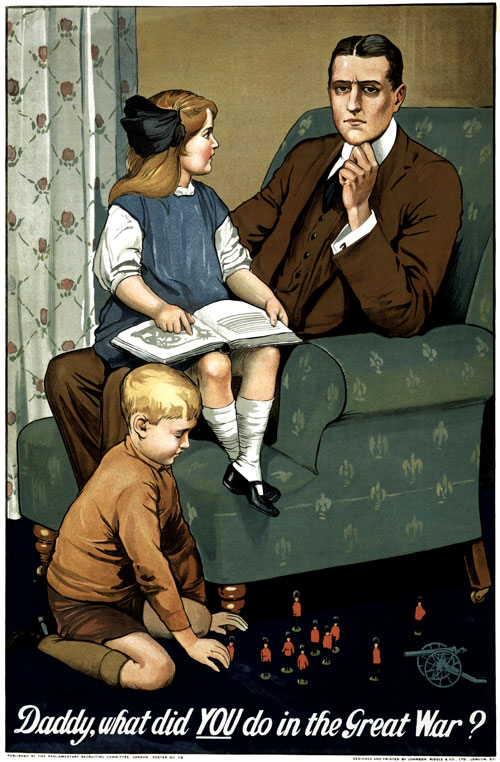
Example - Write an Interpretation of the Poster
This propaganda poster produced by the British government in 1915 sought to persuade British citizens to enlist for military service. It does this by employing a range of propaganda techniques. First of all, the main character is an idealised middle class British family man. The use of this stereotypical character is an attempt to connect with British middle-class men who had not yet joined the war effort. Secondly, the poster uses the symbolism of the toy soldiers, which the young boy is depicted as playing with. The fact that the man's son is more impressed with symbols of war than his own father begins to play on the audience's emotions. Thirdly, the text that accompanies the image, which is spoken by the daughter, inquires about the man's role in the war. The use of the second person pronoun of "you" is a clear attempt to engage personally with the audience. This is reinforced by the fact that the man's eyes are looking directly at the viewer. Therefore, although the girl is talking to her father, the poster intends to directly address the viewer. The clear intent is to make the audience the target of the question so that they will wonder what role they will play in the contemporary conflict. All of these techniques combine with the intention of generating the feelings of shame and guilt in the viewer. The propaganda hopes that young men will feel embarrassed to admit to their future children that they were 'too cowardly' to join the war effort. Even though there is no explicit 'call to action' for the viewer on the poster, the tacit expectation is that the guilt would result in young men enlisting to fight in the hopes of being able to allay the shame produced by the picture. The overall message produced by the propaganda poster is that real men will enlist in the war effort in the belief that their future children will be proud to know that their fathers did their part.